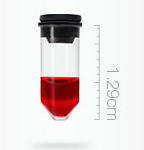We all know that drinking water is very important for our health. However, the water has to be pure. It may appear sparkling and clear, but a glass of water from the average American faucet actually contains a wide range of dissolved substances.
Let’s take a look at the main categories of contaminants that can be found in regular (and safe) drinking water:
Chemicals
VOCs
Volatile organic chemicals (commonly referred to as VOCs) are found in the air and soil thanks to their use in many common products and industrial processes. VOCs are ingredients in petroleum, paints, cleaning products, brake fluids—which gives you an indication of how commonplace they are.
It’s almost impossible to find a home that doesn’t contain VOCs, from varnish to cosmetics. Some of the most frequent examples are benzene, ethylene, and formaldehyde.
The biggest emitters of VOCs are landfill sites, factories, and accidental spills. After entering their aquatic ecosystem, the chemicals can spread far and wide, reaching deep into groundwater wells or surface water. As such, those with private well water sources should invest in a whole house well water filter to prevent these chemicals from entering their drinking water.
Consumed in high amounts for long periods, VOCs can be carcinogenic. But because they’re so widespread, The EPA has established safe limits for their presence in drinking water. This means that even treated tap water is likely to contain some amount.
Chlorine
Chlorine is a disinfectant chemical, which is used by many treatment utilities to reduce the number of bacteria and viruses that might be lurking in the water supply. Data shows that cases of disease caused by drinking water have fallen dramatically since chlorination became standard practice.
Consuming high levels of chlorine can be dangerous to health, but the levels used to treat water in the US are perfectly safe. In fact, we’ve been using chlorine for nearly a century to keep pathogens out of the water supply. However, you can always use a filter to remove them if you simply don’t like the taste.
Chlorine byproducts
When chlorine is added to water that contains a lot of vegetation or dead leaves, it can cause a reaction that creates a group of chemicals known as chlorine byproducts.
While the levels of byproducts in public drinking water are closely monitored and considered safe, there is evidence to suggest that they are carcinogenic. The good news is that byproducts can be easily removed by a quality water filter.
Fluoride
Like chlorine, fluoride is considered by most people to be a safe chemical for daily consumption. First added to the national water supply in the mid-twentieth century, fluorine can protect against cavities and aid dental development, making it especially beneficial for children.
Also, like chlorine, fluoride can be dangerous when consumed at high levels, weakening enamel and even affecting bone density. Recent studies involving lab rats have shown that very high levels of fluoride can have a toxic effect on the nervous system. However, these concentrations are unlike anything found in the US water supply.
According to Harvard public health magazine, the amount of fluoridated dental products now available to the public are reducing the need for added fluoride in drinking water. As a result, the US Public Health Service recently lowered its recommended fluoride levels for the first time.
Microorganisms
Algae
Algal blooms are a big problem for today’s reservoirs and lake systems. By covering the surface of the water, algae can deprive the underwater ecosystem of oxygen and light, leading to stagnation.
Algae also produce a toxin called cyanotoxins, which is far more likely to make it into your glass of H2O than the microscopic algae plants themselves.
Copepods
Some watersheds with minimal filtration processes (famously New York’s) contain copepods, which are tiny, harmless, shrimp-like creatures. Copepods had a moment in the spotlight a few years ago thanks to a social media post alerting people to the fact that they were likely consuming them on a daily basis.
Scientists believe that the presence of copepods in water is often a sign of high-water purity. They’re invisible to the naked eye and are totally safe to drink.
Coliform bacteria
Coliform bacteria are an extremely widespread microorganism in nature—and us! They’re found in our gastrointestinal system and the feces of animals. Because they’re so common, coliform bacteria almost always show up in tests of drinking water. That’s no issue, but when high levels occur, it can mean that other more toxic microorganisms are also present in the water supply.
Minerals and metals
Magnesium and calcium
Usually known as hard water, the presence of dissolved minerals like magnesium and calcium in a supply can change a lot about water, from how it tastes and feels to how it affects your appliances.
Hard water produces scale, which can leave a film on plates and glasses. Due to the way that minerals change the composition of water, it can also be difficult to lather soap, and water may feel scratchy on the skin.
Lead
Lead is a toxic metal, meaning that there are no safe consumption levels. Despite this, lead is found in drinking water in large areas of the country. This is partly due to natural metals in the soil, but mostly occurs thanks to corrosion from old lead piping.
Normally, old pipes contain a build-up of matter that protects the water from lead exposure, but when the acidity or other features of water change, that matter can erode, leaving lead in contact with the supply.
To find out how much lead might be in your drinking water, find and read your local consumer confidence report. The EPA requires every public water system in the country to produce one of these documents each year, which breaks down every substance detected in your drinking water.







